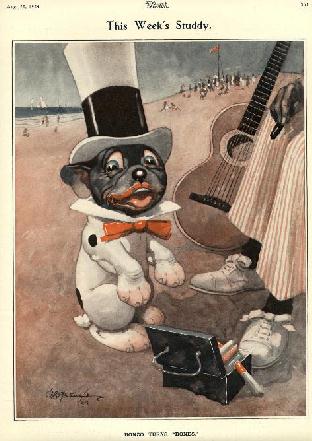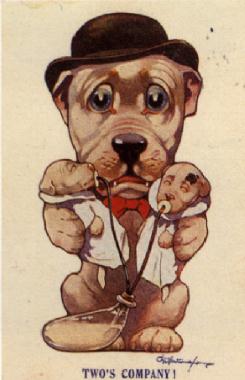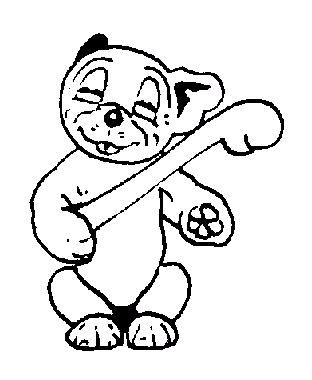| What follows below is the result of a cosy chat that Paul,
Gay and myself enjoyed in late last year. Over a few glasses of a
fine Burgundy, I managed to prise from them a few of their tales as to
how Bonzo has played a part in each of their lives and some of their other
stories. We thought you'd enjoy the (edited) highlights!
Richard: What is the earliest memory each
of you have of Bonzo?
Paul:
I must have seen Bonzo lots of times as a child, but I was really a Rupert
Bear fan at the time. There was an old lady called Alice who had
a newspaper stand near where we lived in east London, and she always saved
me the Rupert books and comics when they came out - obviously on the orders
of my parents! I also used to get 'Dandy' and 'Beano' amongst other
comics and, when I was a bit older I got into the 'Eagle', but I don't
consciously remember being too aware of Bonzo.

Gay: A print of "Bonzo Turns Bones", which
was hung on the wall in the bedroom I slept in as a young child when I
stayed with my Aunt in Surrey for a fortnight each Summer.
P: I'd known Gay from Art School and then
later on when she'd started in the antiques business. She had prints
and bits of Bonzo memorabilia around the flat and I actually used to give
her
things to add to her collection before I got into it myself, so I suppose
I first became really aware of him by visiting Gay. That would have
probably been over 30 years ago.
R: How did you both first become interested
in collecting Bonzo?
G: In 1966, when I first started to deal
in antiques and odd pieces of ephemera, I met Avril and Edward Broad who
had a stall on the Portobello road in London on Saturdays and lived above
their shop in Hastings, on the south coast, during the week. They
sold phonographs, old gramophones, coronation mugs, pieces of brass, bric-a-brac
and old postcards. While staying with them in Hastings I glanced
through one of the postcard albums which contained eighteen Bonzos.
I bought them all for two old pennys each - today that would be 15 pence
the lot! From then on many other friends gave or sold me anything
they found connected with Bonzo, but I think Avril and Edward unearthed
the most.
P: After seeing Gay's collection, which
was quite modest at that time, I had to break it to her that she was to
have a rival and that all future presents were to consist of something
else! I was mainly attracted by Studdy's sense of humour and the
fact that he was an amazing draughtsman. There weren't a lot of Bonzo
collectors around at the time and certainly almost nothing written about
George Studdy. We didn't have any idea what was out there to collect,
or how prolific he'd been for the 25 years or so before the Second World
War.
R: What was the first item in your respective
collections, and do you still have them?
P: I don't really know what I bought first,
but it was almost certainly a postcard. I remember getting the 'I'm
Salt' and 'I'm Pepper' Bonzos quite early on. In those
days postcards were about 3 to 6 old pennies each (roughly 1½ -
2½ pence today). I'm sure I have the first bits as I almost
never sell anything.
 
G: The first three dimensional Bonzo in
my collection also came from the Broads in Hastings. It was a seated
laughing ceramic Bonzo, and yes I still have it.

R: What are your favourite and/or most
treasured items in your collections, and why?
G: It is impossible to choose just one item.
One of my favourite images is "Two's Company", and I'm very lucky to have
the original painting. It describes perfectly the feelings of a new
father. Also I love "Bally-ho Old Bean!" (see page 93, postcard no.
2391 in our book), because it shows Bonzo having such a good time.
One more favourite - there are so many - is a rare Pan Yan Pickle poster
because it was given to me by George Studdy's brother Hubert. It
was not in a very good condition and he sent it to me folded in an envelope
marked 'open tenderly, an invalid inside'.

P: There are so many! I was lucky
that 25 years ago illustrators and cartoonists were not held in high esteem
by the art world as much as today, so I was able to buy quite a few original
paintings and drawings relatively cheaply. A lot were sold by Hodgson's
Rooms - a book auction house now incorporated in Sotheby's. Gay and
I just kept on bidding until we'd got almost everything - about 30 lots
spread over five or six sales. My real favourite isn't actually a
Bonzo, he's on postcard #348 - "I 'shure you I'm not!". It's
an unbelievably delicate bit of painting and, at the time, cost me £50,
although I could never sell it! I'm also very fond of the Cowan's
Toffee pail (page 65 in the book). I swapped it for some old toys
that I'd collected over the years, it's quite worn but I love
it.
R: How did you first meet up with each other?
G: As Paul mentioned earlier, we went to
the same Art School in Walthamstow, north-east London. Paul left
the year I started (in the early sixties) but we met through mutual friends
and got on so well, we've been great friends ever since.
P: We certainly have!
R: How long after that first meeting did
you decide to compile and write your book?
P: Gay and I had always collected together
but separately. If something came up and I couldn't afford it, I'd
tell her and vice versa. When we started, we knew nothing at all
about Bonzo and even less about George Studdy. At some point we decided
to try and find out their history. It was totally for our own information
and was to be private research for our own curiosity. We'd go to
the British Library and source as many book titles as we could, and Gay
spent days in the newspaper department of the Library at Colindale, north
London. All the time we were going to postcard and antique fairs
to add to our collections as well.
G: When I first started accumulating Bonzos,
Paul was one of the friends who looked out for them for me. Within
the year he decided that he loved them himself and started his own collection
which he built up very quickly and it wasn't long before between us we
had quite an impressive collection. Paul suggested that we should
write a book together in 1978.
He got a pass for the British Library and I followed suit. We
found quite a lot of interest there and from the newspaper library in Colindale.
We went religiously to as many postcard fairs as we could. Paul also
contacted other collectors to complete the postcard catalogue in the back
of our book, for which he must take most of the credit.
R: How difficult was it to find all the
background information that you needed for the book?
P: Very difficult!! There wasn't much
written about Studdy and, as with most research, it's very dangerous to
assume that all printed information was accurate. We virtually had
to start with a clean slate and it became a real piece of detective work.
Gay started with the obvious and telephoned all the entries under Studdy
in the phone book! That put her in touch with his brother, Hubert.
We also went to look for the birth, marriage and death certificates, and
generally anything that was on public record. Meeting Vivienne, his
daughter, was a real breakthrough, although we'd rather been pipped at
the post as she'd signed an agreement giving the book rights to somebody
else. That wasn't too much of a problem because all we wanted was
to see a good book on Bonzo published.
G: 1978 was the year I first contacted Hubert
Studdy, George's younger brother. He refused to meet me but wrote
me many amusing and interesting letters about his brother and his family.
When he died a year later, his widow Gwynneth contacted me and we became
friends. Gwynneth put us in touch with Vivienne, George Studdy's
daughter. Vivienne's help was invaluable.
P: When the book agreement lapsed, and with
no book having been published, Vivienne offered us the chance to take over.
We stepped up our research but, as we both had businesses to run, we couldn't
afford too much time on the project. We'd meet most Fridays to discuss
what we'd found out in the week. We had a lot of trouble finding
a publisher willing to take on the book - very few like to take a gamble
and to most of them Bonzo wasn't well enough known. I was staying
with an old friend, Richard Dennis, at his home in Somerset - in the south
west of the country - and he asked what luck I'd had. Although he
mainly publishes books on ceramics, he offered to back us with Bonzo (he's
since done books on the French cartoonist Raymond Peynet, Chloë Preston,
Arthur Elsley, and soon will be publishing the works of Mabel Lucie Attwell).
We had a lot of luck in finding the information, but it involved hours
of unproductive research as well!
R: Do you both still collect Bonzo/Studdy
items?
G: Yes, but it is increasingly difficult
for Paul and I to find items we haven't already got!
P: Absolutely! Thankfully having built
up a decent collection early on, we don't have to look for too much, but
we still have to bear in mind our budget and not get carried away unless
it's something really special. Patience is an important virtue!
R: Finally, do you think Bonzo's popularity
will continue, and have you any tips for new collectors?
P: Apart from collectors and those who remember
Bonzo first time around, there is evidence that there are a growing
number of new enthusiasts. Bonzo is licenced by Gresham Marketing
Gmbh who, although based in Kaiserslautern, Germany, represent Bonzo
throughout the world. There are currently several projects under
way involving new merchandise - some mass market items and some for collectors.
A series of 12 reprints of original postcards was issued recently by Mayfair
Cards of London, UK who had changed the captions only slightly to bring
them up to a modern day meaning.

G: I would suggest collectors scour the
markets, postcard fairs, salerooms, junk shops and collectors publications.
P: The collecting market is very strong
world-wide at the moment, and shows no sign of slowing down. The
easiest things to start collecting are probably the postcards which are
comparitivley cheap, and are in the stocks of most postcard dealers.
It's possible to get them at very low prices from general dealers, but
it usually involves ploughing through endless shoe-boxes of assorted cards,
and even then there may not be any there. The postcard fairs around
this country are very well organised and most dealers have sorted their
cards and know their stock. If you ask for Bonzo cards they usually
go straight to them. On some occasions they might just hand you a
batch of general 'Comic' cards, but at least they're narrowed down for
you. It's worth keeping an eye out in junk shops, etc. where they
might not know what they've got but specialist dealers are, quite rightly,
the correct price, but they've done all the leg work for you and probably
paid a decent price themselves.
There are a number of postcards produced by Valentine's after Studdy's
death, drawn by another (inferior) artist, along with the Bonzo Annuals
published by Deans from 1949 onwards. I personally wouldn't pay nearly
the sum of money for them because the quality is dubious in comparison.
Likewise there are many Bonzo look-alikes that were done in Germany and
Austria which are only interesting from a curiosity point of view.
In most, but not all, cases Studdy's signature is your only guarantee!
G: I'm sure Bonzo's popularity will continue.
Although some of the captions and situations are definitely dated, I think
Bonzo's charm is timeless!
With thanks to both Paul and Gay for their time and a jolly pleasant
evening!
Richard Fitzpatrick January 1999
 |





